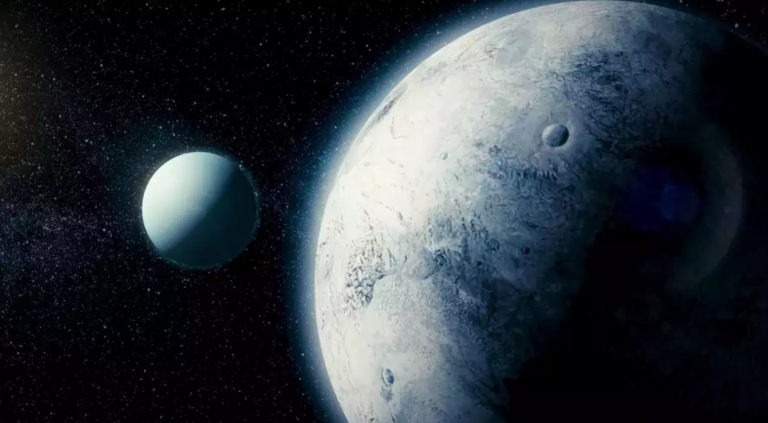Hidden Subsurface Ocean Possible on Uranus’ Moon Ariel
Ariel’s Hidden Ocean Could Explain Its CO2-Rich Surface and Clues About Cryovolcanism Beneath Uranus’s Moon
Scientists of the astronomical observatory have been able to establish that the Ariel moon in Uranus could contain a lightless ocean of water below its icy surface through help of the James Webb Space Telescope. This potential ocean could be refilling the Ariel carbon dioxide rich surface. Spectral analysis of the light which reflected from the telescope showed Ariel’s chemical makeup which consisted of such gases as carbon dioxide and carbon monoxide; both of which should not be stable at the lunar temperatures. This indicates that these compounds could come from a subsurface ocean and are probably released through cracks or cryovolcanic eruptions. Calcium carbonate is located in Ariel’s icy mantle, which proves the existence of the ocean beneath the icy surface; thus, the necessity to launch a mission to Uranus and its moons.
This discovery helps to answer the question that has puzzled scientists for some time about the nature of Ariel, namely why its surface contains so much CO2 ice. That, since Uranus and its moons are 20 times as far away from the Sun as Earth is, carbon dioxide would ordinarily sublimate, or turn directly into a gas, and therefore be lost to the system; the fact that Ariel possesses a carbon-dioxide-rich ice, therefore, strongly suggests that something is replenishing this compound on the satellite’s surface.
Prior theories postulated that alteration Ariel experiences due to charged particles from Uranus’ magnetosphere eradicating molecules in its ambience ionising it through a process termed as “radiolysis” from where the required replenishment may be occurring. However, the new evidence from JWST has shown that the carbon dioxide could possibly be derived from the submarines ocean that is possibly existing beneath the surface of Ariel.
Due to the JWST’s light spectra analysis Ariel’s chemical composition could be deduced by comparing the observed spectra with the simulated lab spectra. By comparing the depth of Ariel with asteroids and other objects in the solar system, it was found out that the surface of Ariel contains some of the highest levels of carbon dioxide which are found in the system. Also, the analysis was able to identify the presence of carbon monoxide for the first time even though the surface temperature of the moon is 30 degrees Celsius higher than the temperature that is necessary to stabilize the carbon monoxide.
John Hopkins Applied Physics Laboratory’s Richard Cartwright said, “It just shouldn’t be there. You’ve got to get down to 30 kelvins [minus 405 degrees fahrenheit] before CO is stable. ” This means that the CO needs to be supplied. Although part of this replenishment may be due to radiolysis, as Voyager 2 noticed in 1986, and recent data indicates that Uranus has a tilted magnetic field axis by 58 degrees from the moons orbital plane. This means that majority of the carbon and oxygen compounds visible on the surface of Ariel can actually be produced from chemical reaction happening in a subsurface ocean underneath the ice shell of the moon.
Ariel might seem cool, but it could have a fiery side
Carbon oxides generated from Ariel’s oceans could be seeping through icy terrain or through cracks in the moon or being ejected out by cryovolcanoes which are like volcanoes but instead of emitting molten rock they spew out icy slush. Many researchers have for quite some time now hypothesized that Ariel has a broken and damaged surface, which makes it possibly an active cryovolcano, which may eject material into the Uranian magnetosphere.

It turns out that most of the cracks and grooves on Ariel, such as Ad, are oriented with their associated long axes pointing away from Uranus. If carbon dioxide and carbon monoxide are being exhausted from these features then it may well account for their higher concentration on the trailing hemisphere of Ariel.
Further, the JWST also offered extra chemical proof of the existence of a concealed subsurface ocean. Spectrophotometric data are related to carbonate minerals—that type of salts which appear as a result of interaction between the rock and liquid water.
Richard Cartwright said: “If our interpretation concerning that carbonate feature is correct, then this really suggests internal formation, although work is needed in terms of future observations, modeling or combined approaches to ensure. ”
No other spacecraft has gone to Uranus and its moons after the Voyager 2 flyby nearly four decades ago and that mission’s objectives were not confined to Uranus orbit. The 2023 planetary science and astrobiology decadal survey pointed to the fact that it is high time for the Uranian system to be allocated a special mission.
The author of this article seems to agree with Cartwright that such a mission could offer very important information on Uranus and Neptune and also on the other moons in the said systems that may possibly have oceans. These insights could also help enhance the current knowledge and discovery of new born exoplanets- planets located outside our solar system.
A Uranian system expositor and a team member, Ian Cohen of the NASA Applied Physics Laboratory described these new disclosures as follows: “It only appears sizzling that there are many unknowns concerning Uranus and its environmental surroundings Many in the planetary science community are looking forward to a future Uranian mission to unravel the origins of our solar system, study the Uranian magnetosphere, or consider whether these moons might be ‘ocean’ worlds”.
The team’s research was published on July 24 in The Astrophysical Journal Letters.
Do not forget to share your opinion with us to provide you with the best posts !




0 Comments